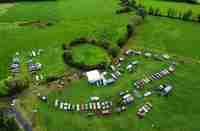‘Every company has a disaster relief plan’
Earlier this week, my colleague Michael Finan and I took to the roads of Roscommon. Twelve days had passed since Storm Éowyn swept through, yet its impact still loomed large. Some communities remained without power, while others were left grappling with damage to local infrastructure. As we drove, we reflected on the devastation, and the resilience of the people.
In Ballyleague-Lanesboro, we met local community activist and well-known shop owner Joe O’Brien. Joe gave us a sobering account of the destruction wrought upon the local sensory garden, a project that had been poised for transformation. The garden, initially kitted with temporary equipment for children with autism, was set to become a permanent fixture thanks to a recently approved council grant. But before the planned upgrades could be made, Storm Éowyn made landfall.
What remained was little more than debris. Greenhouses, pods, and canopies lay scattered. A fallen tree blocked access near LanesBrew Coffee House. The once-inviting space was now a ruin, its centrepiece – a sensory rock – surrounded by uprooted trees and shattered pots. As we stood in the wreckage, we could hear children playing in the yard of the adjoining school, which has two dedicated rooms for children with autism. This garden was meant to serve them. It was meant to serve the wider community. Now, all that remained was a stark reminder of how quickly progress can be undone.
Back in Joe O’Brien’s shop, Joe welcomed us as we took shelter from the biting cold. Michael, a contemporary of mine but a few years younger and from the other side of the county, gestured towards a towering structure and asked, “What’s that big building?”
“That’s the decommissioned, peat-powered power station,” I told him. “It used to burn the peat to generate electricity. Now it’s being dismantled”.
This exchange seemed to capture something fundamental about the conversations we were having all day: the changing landscape of energy, the push towards sustainability, and the unintended consequences that came with it.
When I asked Joe O’Brien what lessons had been learned from Storm Éowyn, he didn’t hesitate. “Not many,” he said, bluntly.
Joe spoke of how, despite the storm’s clear warnings, the local authority had pressed ahead with its plans to renovate a cottage in the village, removing its range and stove and planning to seal its chimney in the process. This, he pointed out, flew in the face of what had just happened. Over the past fortnight, countless families had relied on solid-fuel to stay warm. Without them, he quite rightly said, people would have frozen in their homes.
Joe then told me about his son, who lives in Roscommon town in a fully electric-dependent home – electric heating, electric gates, electric cars. A model of modern energy efficiency. But when the grid was struck, his home went dark. For hours, he was without power, but for anyone still without power 12 days on there is little doubt the dependency would be disastrous.
Joe’s son was lucky. The power in Roscommon town was restored quickly. But the question remains: as we continue to build homes without chimneys, as regulations increasingly push us towards all-electric solutions, are we setting ourselves up for a vulnerability we don’t yet fully understand?
Ballinameen emerges into the light
As we pressed on through the roads of Roscommon, our next stop was Ballinameen, where we visited the local national school. Principal Mr McDermott, a native of the area, had spent the past decade teaching in Dublin before returning home in September to take up his new role. When we met him, there was a quiet pride in his voice as he spoke of the joy and excitement the children had felt upon their return to school that morning. Yet, looking back on the past week, he reflected modestly on the effort he and the wider community had put into ensuring that essential services were available to those left in the dark – both figuratively and literally.
While much of North Roscommon was without power, Ballinameen National School, and many others, became a lifeline. Over the weekend, the school opened its doors as a community hub, offering people a place to boil water, charge their phones, and access Wi-Fi. This was no small gesture. For many, it was a critical link to the outside world during a time of prolonged disruption, particularly for those who didn’t have any local links.
Beyond the school itself, the storm had left its mark. Fallen trees surrounded the grounds, and the school’s main power line had narrowly escaped being taken out by one particular tree. Now, the focus was on securing emergency funding from the Department of Education for the removal of the damaged trees.
Added cost for communities
On day twelve after the storm, in the Lavagh area of Ballinameen, residents were still without power.
We met Florence Kearney, originally from Roscommon Town but now living in Lavagh. Seated beside her Stanley stove – the warmest room I had entered that day – she welcomed us in. Her home, with its hand-moulded, lime-rendered walls, was a reflection of authentic Ireland. But the comfort of a stove and a well-built home did not mask her growing frustration.
Four adults and one child lived in her house, and she was acutely aware of the inequities exposed by the storm. While she had nothing but praise for the ESB and Irish Water crews working tirelessly on the ground, she was deeply disappointed by the response from agencies and authorities at a national level: “Every company has a disaster relief plan, and whatever happened, those plans either weren’t or couldn’t be executed”.
In 2025, in Ireland, one would hope never to hear what Florence told us next. For the first three days following Storm Éowyn, many houses had no running water. For some, the problem persisted well into the following week. Florence was fortunate – her water was restored relatively quickly. But what about the elderly, she asked? Those who, without power, had to travel to the shops daily because they had no fridges, no freezers. The empathy for those on fixed and limited incomes was a common trend throughout the day.
This is the side of the storm’s aftermath that often goes unnoticed. We speak of fallen trees and power outages, but we rarely think about the quiet struggles – people forced into daily treks for essentials, parents trying to comfort children in cold, dark houses, the elderly left to cope without the basic utilities many of us take for granted.
Boyle Family Resource Centre – an example of ’meitheal’
Our next stop brought us to the Boyle Family Resource Centre. Here, we met with Louise Moran, the centre’s manager and a key figure on the Community Storm Response Group led by Roscommon County Council.
Louise painted a picture of both devastation and resilience. Across the county, 37 community organisations had mobilised to support those without power. The resource centre itself had become a lifeline. For expectant mothers. For newborns. For entire families. For elderly residents in need of warmth and safety.
Though many had their power restored over the weekend, pockets of North Roscommon remained without electricity as we went to print.
Neighbours helping neighbours
From Boyle’s rural hinterland, we met Mags Cryan, who spoke with deep compassion about the struggles of those around her. She told us of the true community spirit in evidence locally.
That same spirit was evident everywhere we went. From GAA clubs to schools to local businesses, the communities across North Roscommon had rallied to ensure that the most vulnerable were not left behind.
Patience dwindles
As the recovery pushes into its third week for some, patience is wearing thin.
“I do what I can to stay out of the house as long as possible,” Mags Cryan admitted when I asked how she was coping with the long, dark evenings. With a wry smile, she quipped that her farmer’s hat, equipped with a light, had become essential for night-time reading.
The frustration wasn’t with the ESB crews themselves. If anything, their efforts had been met with widespread praise for their dedication. The anger, however, was directed elsewhere – towards a government that most feel failed to plan and whose response for many in North Roscommon felt was severely lacking.
Time and again, we heard the same sentiment: this would never be tolerated on the east coast. Several people told us they had previously lived in Dublin or along the commuter belt and had never experienced such prolonged power outages.
What now?
As Louise Moran and her team at the Boyle Family Resource Centre continue their daily engagement with Roscommon County Council and the Storm Response Group, their focus remains on those still waiting for power. Hopes are pinned on restoration efforts being completed by this weekend.
But beyond this storm, beyond this recovery, a larger question looms. How many more times will rural communities in the west be left waiting in the dark? How many more storms will it take before the necessary investments are made to fortify our infrastructure?
The silver lining in the storm cloud of Éowyn has been the unbreakable spirit of the people of Roscommon.
A young perspective
At the Boyle Family Resource Centre, amidst the storm response efforts and community outreach, we had the opportunity to speak with Amélie Frazer, a third-year student at Abbey Community College in Boyle.
Amélie is in the thick of her mock exams, a crucial milestone for any student. But studying under normal conditions is one thing – preparing for exams by candlelight is quite another.
Thankfully, she has the refuge of the Boyle Family Resource Centre during the day, along with the support of her school. But the disruption caused by Storm Éowyn extended beyond electricity.
Telecommunications were also down for a while, which brought an unexpected mix of consequences. On the one hand, Amélie admitted that being cut off from certain apps and devices may have helped her focus. On the other, it significantly hindered research and project work – something that would have been unthinkable a generation ago but is now an integral part of modern education.
For many of us, the idea of completing schoolwork without internet access isn’t all that foreign. We grew up in an era where research meant flicking through encyclopaedias and making do with whatever books the school library had to offer. But for today’s students, digital access isn’t a luxury – it’s a necessity. And when it’s taken away, the impact is real.
Amélie, for her part, is getting on with it. Studying in whatever way she can. Making use of whatever resources are available. And, perhaps most importantly, appreciating the simple act of going to school – something that so many of her peers have been deprived of in recent weeks.






